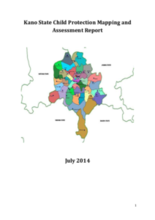CHAPTER ONE: Introduction
Countries throughout the world have begun to systematically reform their child protection systems. This process has involved moving from an issue/response approach towards the creation of a protective environment and strengthening the child protection system. The Federal Government of Nigeria decided in 2010 to be part of this global and regional initiative. As such Lagos state decided to be part of a pilot test to map and assess the existing components of the system. Child Frontiers was recruited to undertake the mapping and assessment of the current child protection system in Lagos state. After that assessment was completed in 2013, USAID agreed to support the mapping and assessment of the child protection system in an additional six states of Nigeria: Benue, Edo, FCT, Kaduna, Kano and Plateau.2 USAID agreed to support CapacityPlus (part of IntraHealth International) and UNICEF to oversee the mapping and assessment in the six states. CapacityPlus coordinated logistics and administration; UNICEF oversaw programmatic issues. The Ministries of Women Affairs and Social Development (MWASD) in each of the states and the Social Development Secretariat in FCT enthusiastically supported the initiative.
UNICEF, CapacityPlus and USAID approached Maestral International to provide technical assistance to carry out the mapping and assessment in Nigeria. Maestral has mapped and assessed child protection systems in many countries, particularly those in east and southern Africa, using the Mapping and Assessment Toolkit and methodology it developed at the request of UNICEF.
1.1 The Child Protection Mapping and Assessment Toolkit
The Toolkit provides a practical method to enable participants to identify the main country child protection risks and gaps within a child rights framework, and to examine the structure, functions and capacity of the existing child protection system (both formal and informal, national and sub-national), the continuum of care, accountability mechanisms and resource mobilization approaches. The Toolkit is an Excel-based instrument to gather information about all aspects of a country or state’s child protection system (CPS). The toolkit consists of 22 tools divided into five main sections (General Country Information, System Overview, Child Protection Continuum of Care, Resource Mobilization and Fiscal Accountability, and Summary and Strategies).
The Toolkit primarily gathers existing secondary data, supplemented with interviews of key informants and focus group discussions. In addition, the Toolkit is linked to many data sources providing information about child protection systems in general and about each country’s child protection system specifically. As the system is mapped, the Toolkit enables participants to identify system building priorities (recommendations) that are needed to address the main gaps that have been identified.
1.2 Objectives and Process
The main objective of the mapping and assessment is to identify the major gaps in the current CPS in each State to provide the basis for specific suggestions on how to improve the existing CPS at the State and LGA level. The mapping and assessment also includes a public financial review of all child protection related services and expenditures in all relevant ministries in each state which will be used as an advocacy tool to increase public allocation and CPS expenditure.
The findings of the assessment will also be used as a mechanism to promote better coordination among partners to optimize their support to the development of each state’s CPS. In particular the findings will be used to determine the extent to which services are appropriate for and are reaching the most vulnerable children, the quality of such services and the extent to which the services are gender sensitive. This information will assist Nigerian State governments and partners to increase access and improve quality of service delivery for vulnerable children. The assessment will also identify areas in which the Nigerian state governments require capacity building to fulfil their obligations as duty bearers. The findings will furthermore be used to determine government expenditures on child protection services and the extent to which state governments are using evidence-based arguments in their efforts to increase the budget allocations for child protection.
The mapping and assessment uses a collaborative, inclusive and transparent methodology in which stakeholders throughout the CPS participate in a Technical Working Group (TWG) to reach consensus about the strengths and weaknesses in the CPS, and to develop a strategy for reform. The Ministry of Women Affairs and Social Development (MWASD) in each state is the lead child protection ministry and led the initiative in their respective state. Other government ministries and agencies (e.g. Planning, Justice, Police, NAPTIP, Health, Education), nongovernment organizations (e.g. Child Protection Network), and representatives of the formal and informal sectors participated in the mapping/assessment process.
The mapping and assessment in the six states of Nigeria was completed in ten months beginning in September 2013 with an orientation workshop until the completion of the state strategic action plan for each State in June 2014. This was the first time that mapping and assessment of so many states was carried out in one country anywhere in the world.

